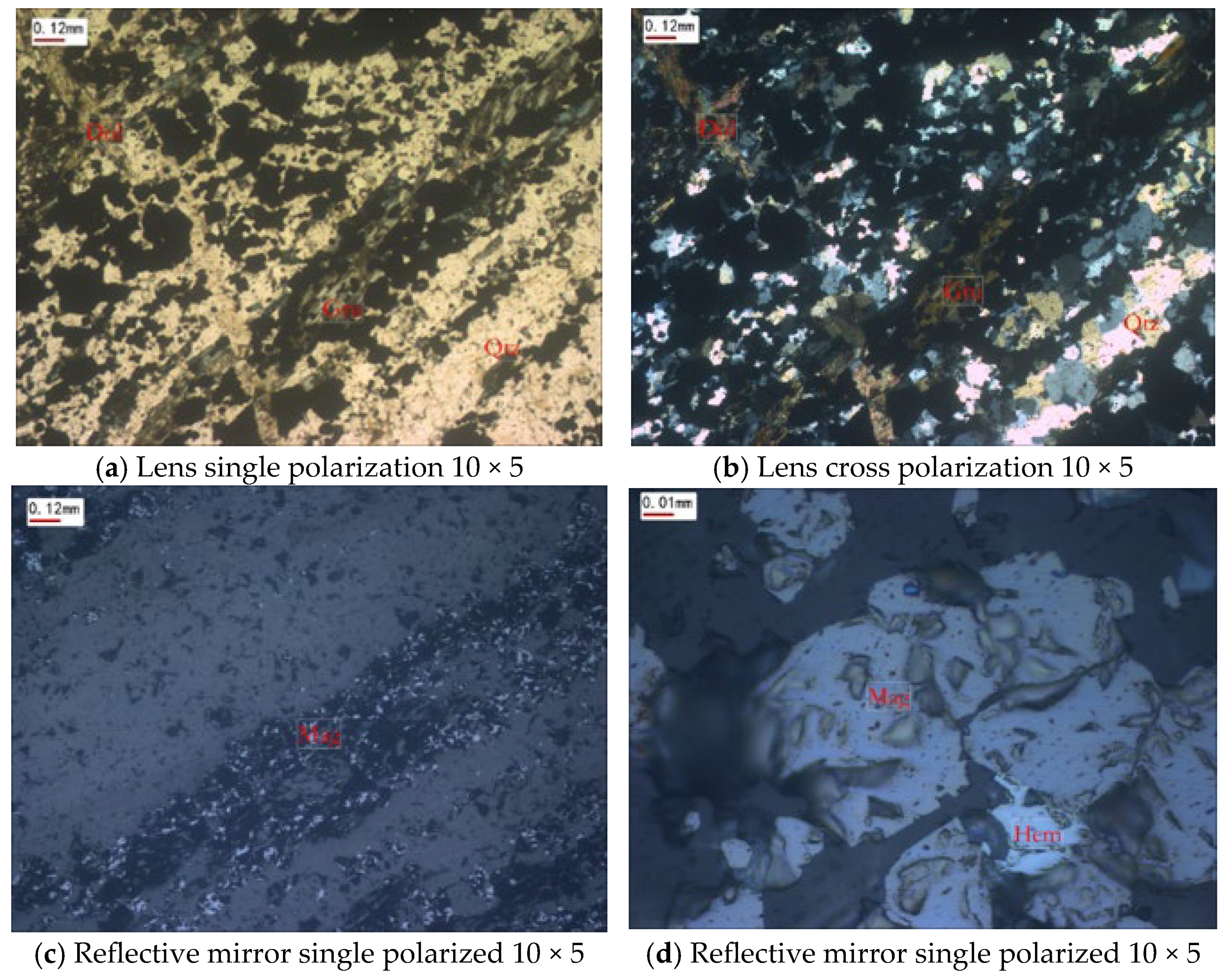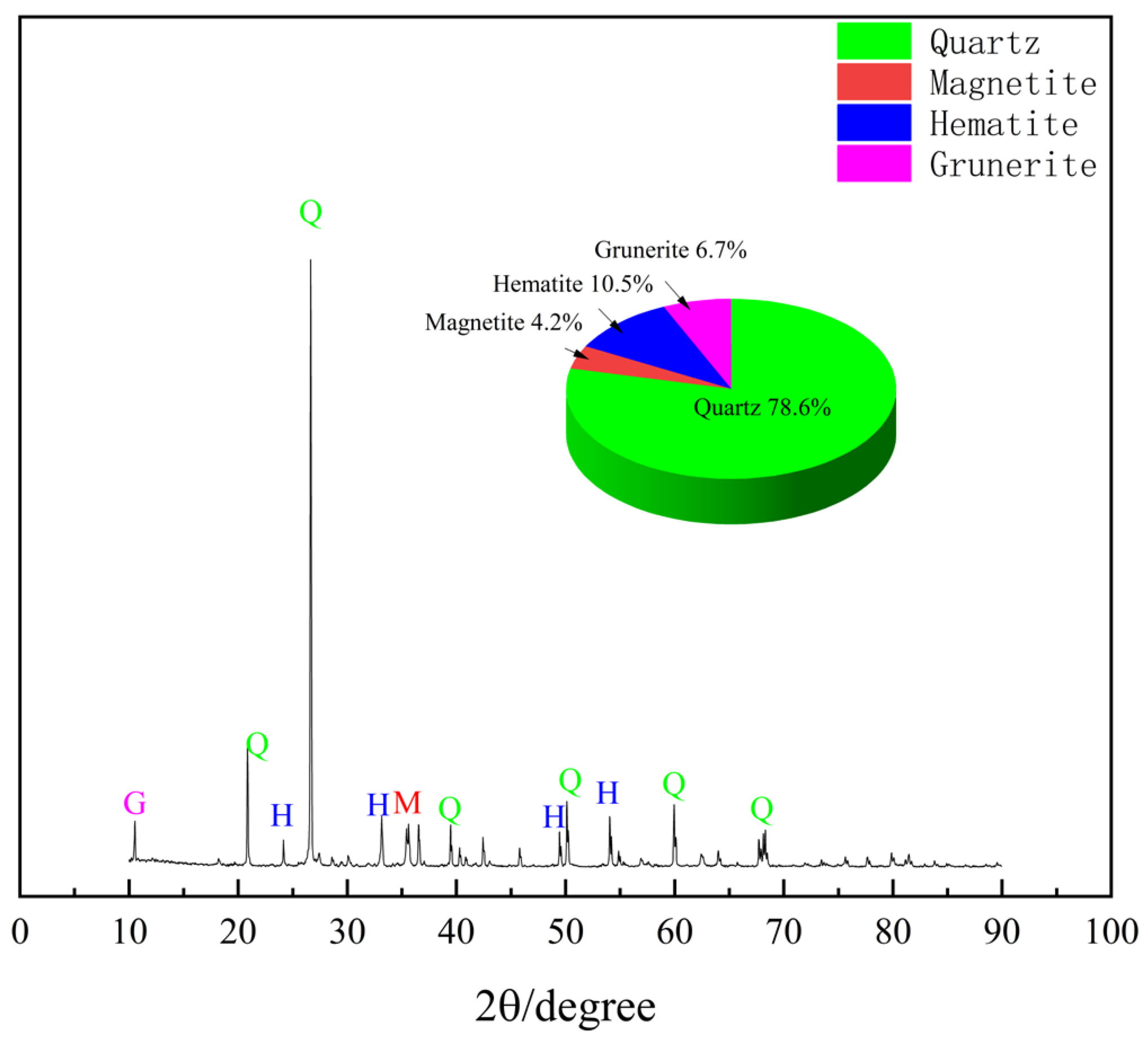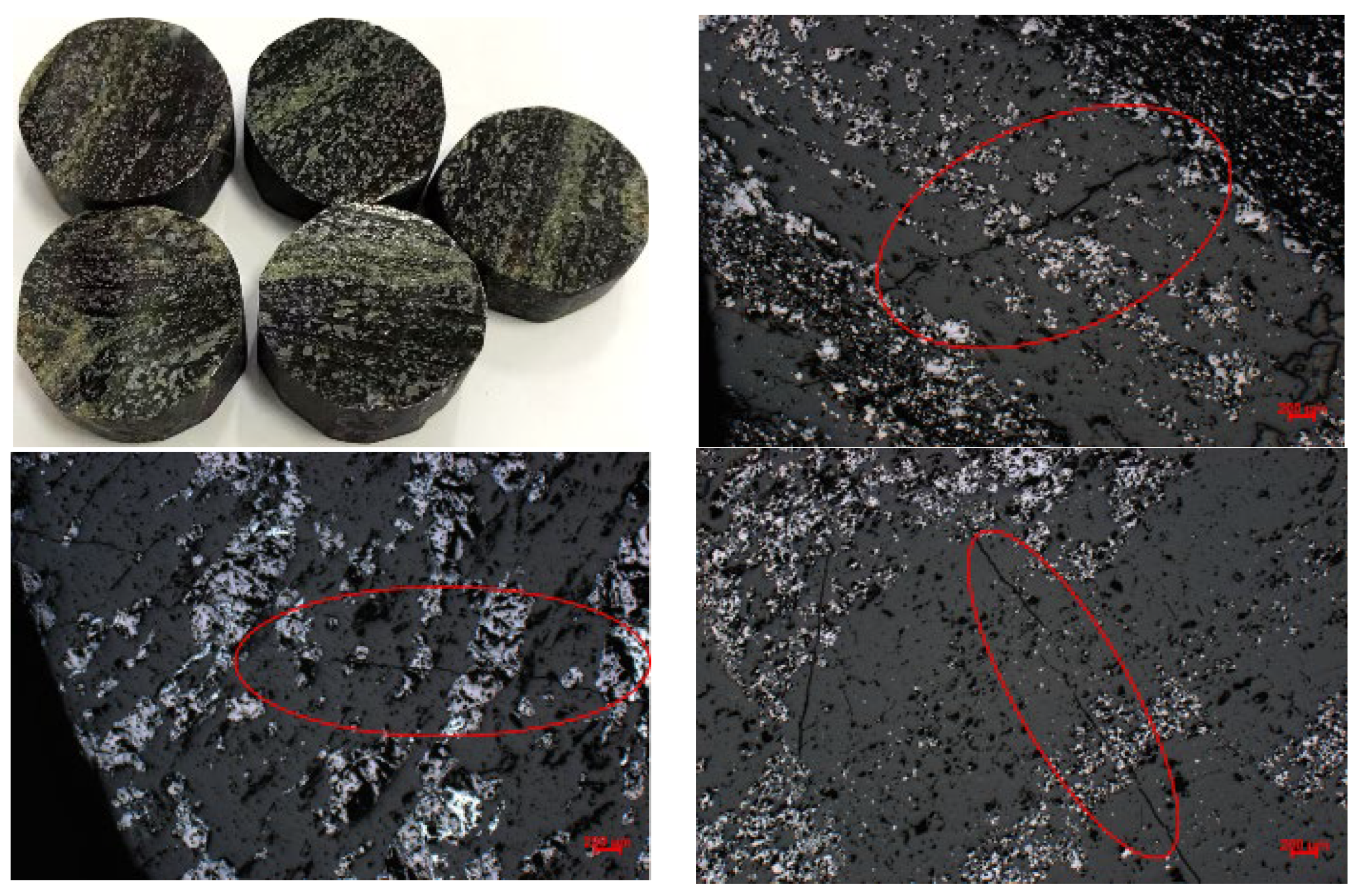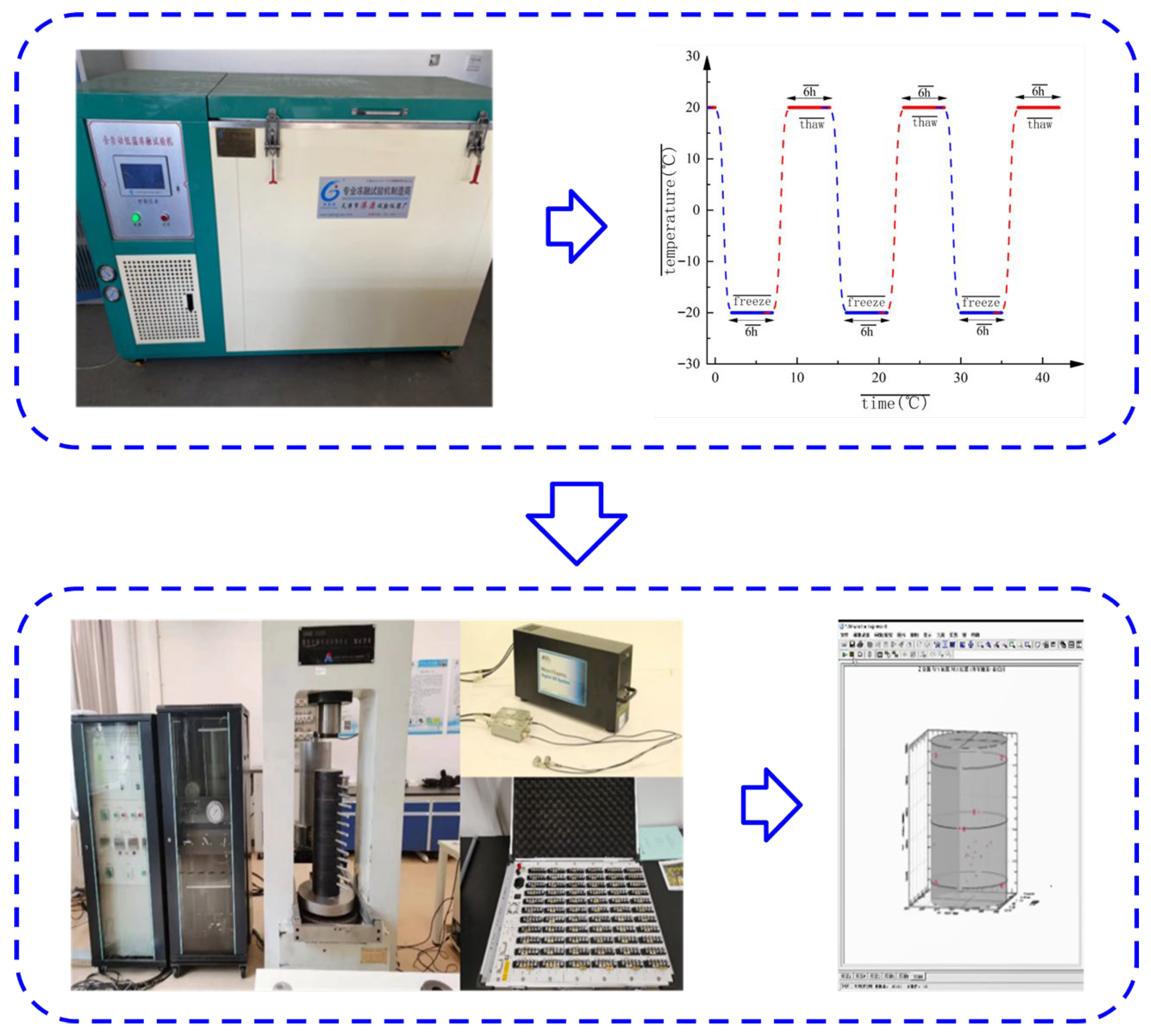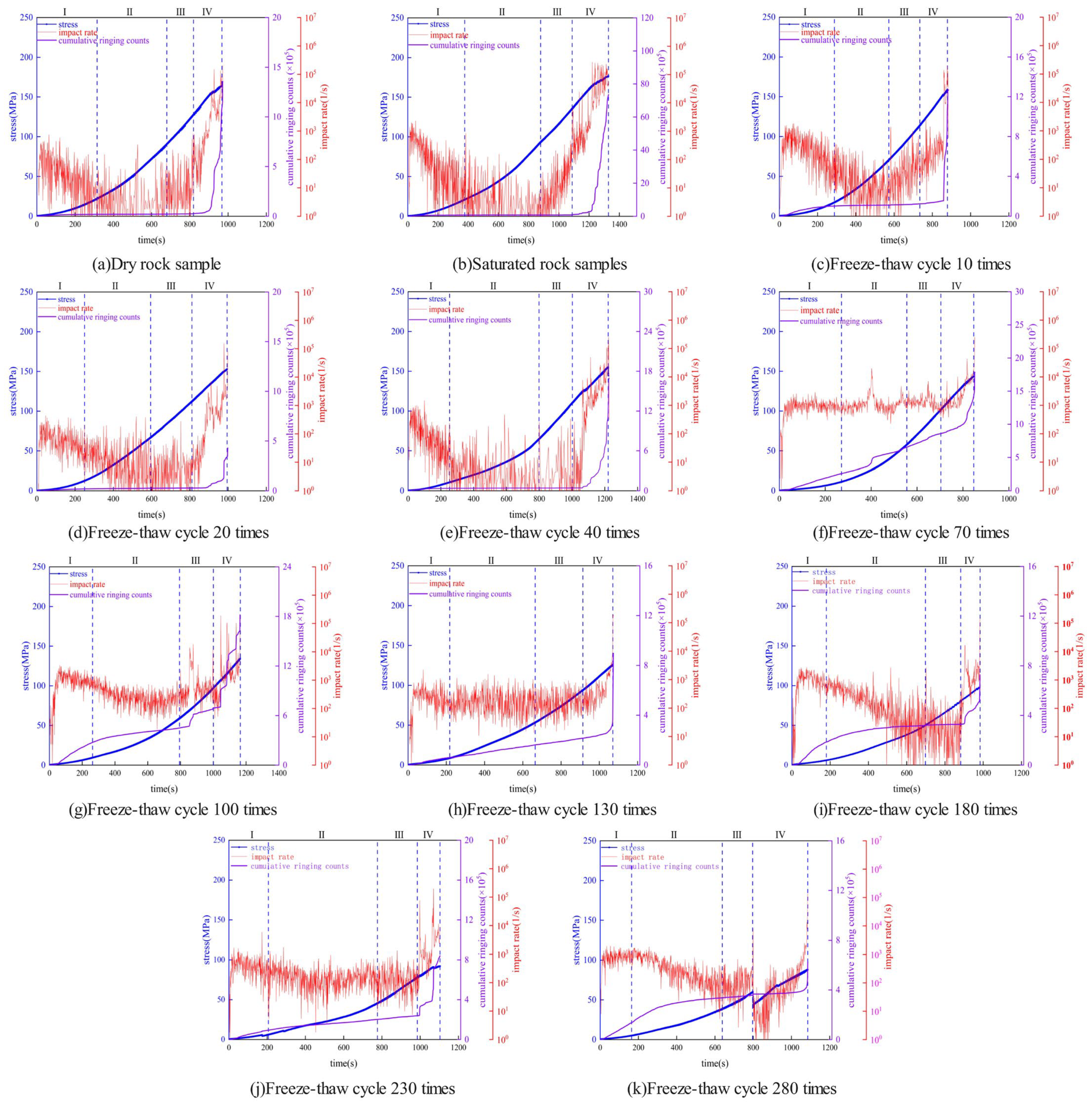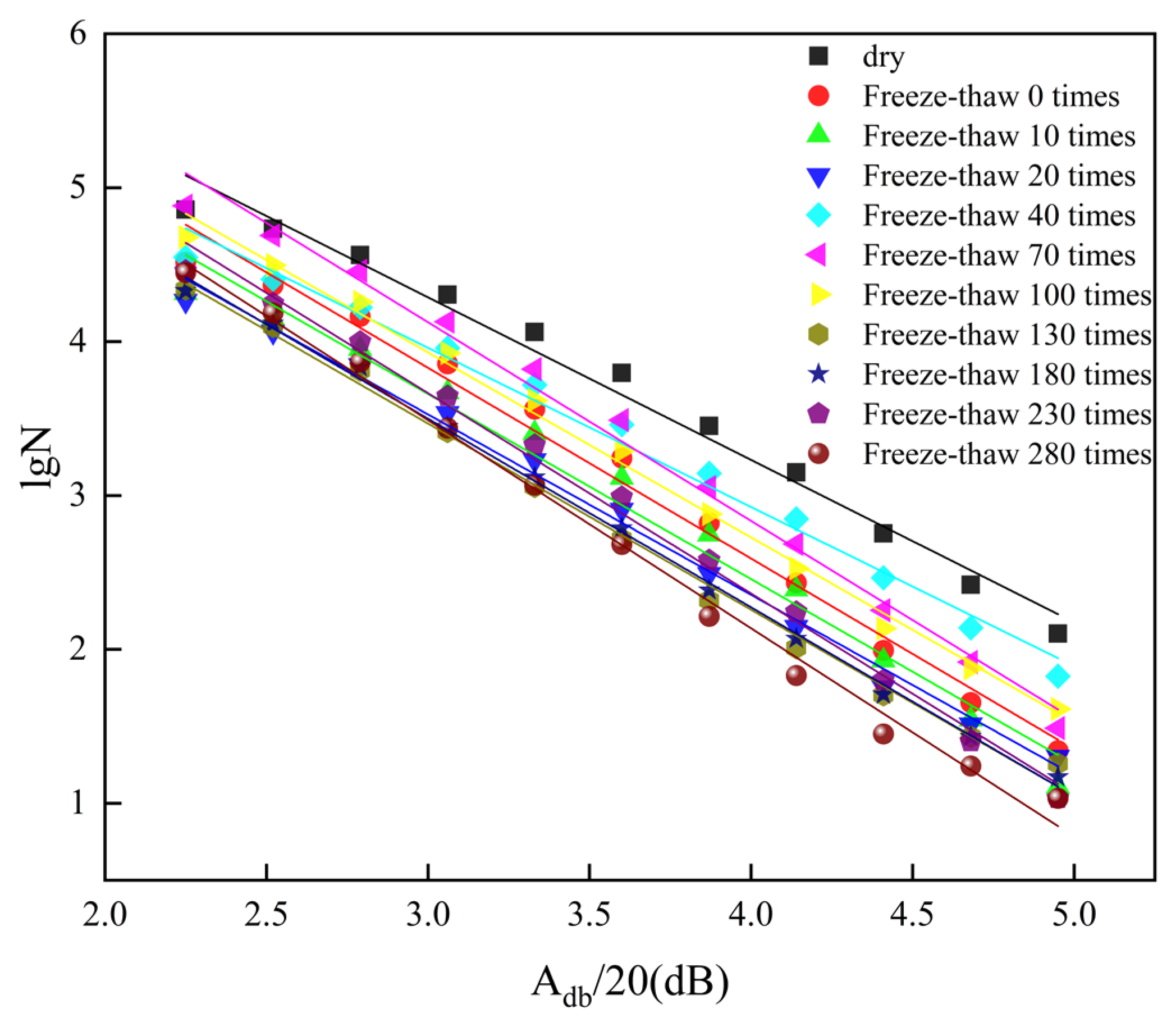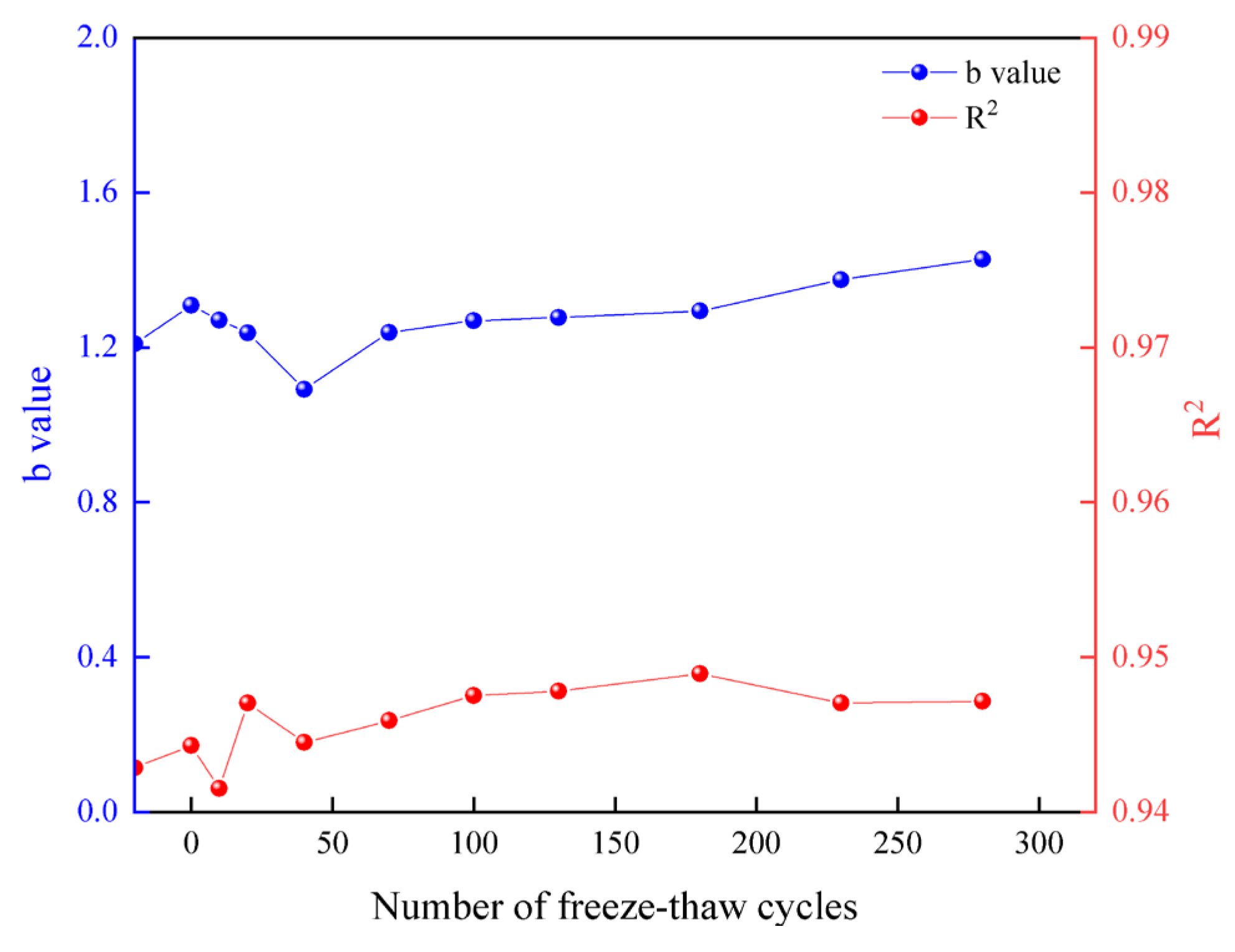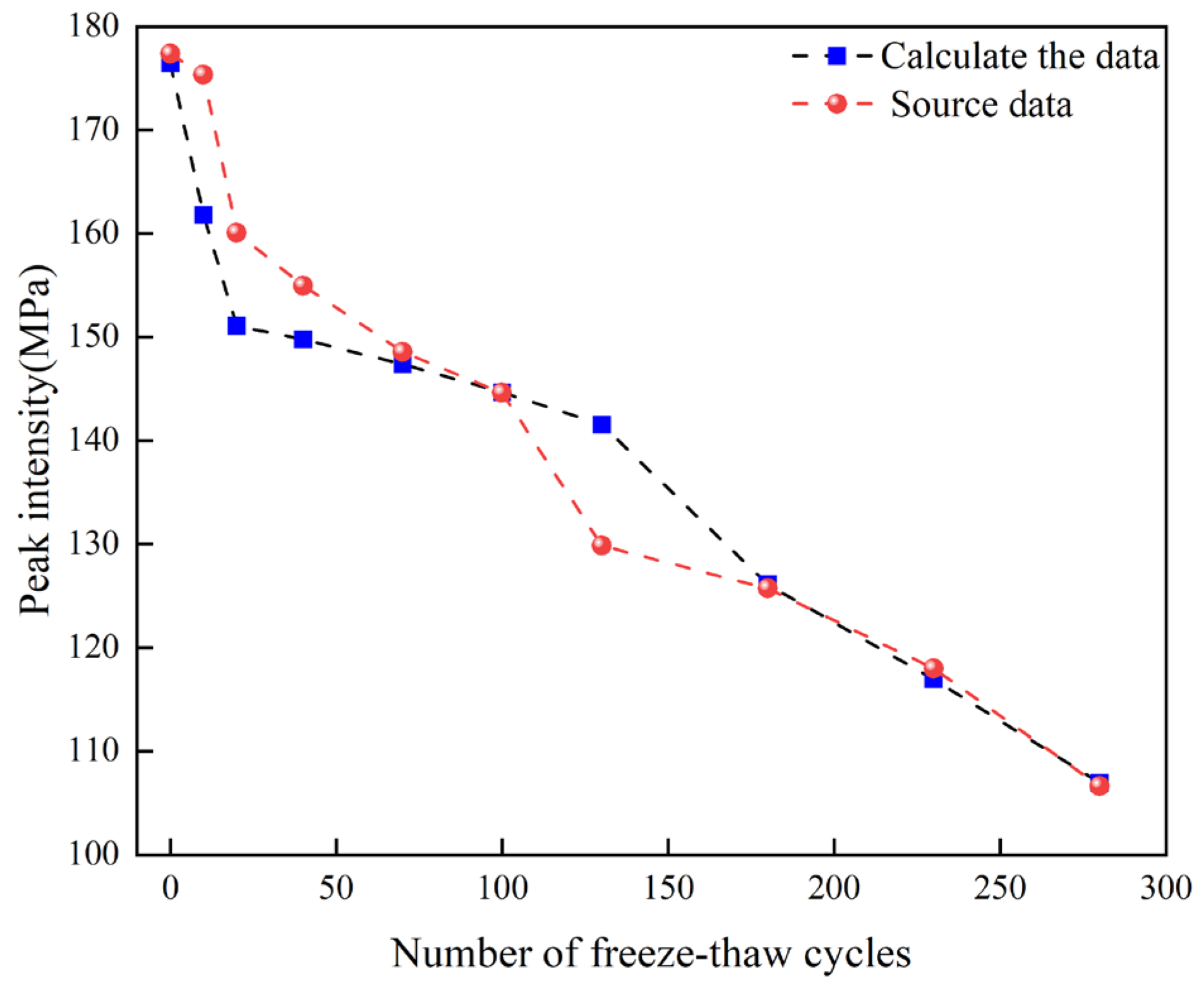1. Introduction
China is one of the countries with the most extensive distribution of cold regions in the world. Including seasonally frozen ground, cold regions cover approximately 70% of the country’s territory. Engineering, construction, and resource development in these areas play a significant role in the national economy [
1]. In the process of repeated freezing and thawing due to seasonal changes or day and night alternation, the development [
2,
3,
4], expansion, and increase in cracks in the rock lead to the instability and destruction of the rock structure, thereby causing freeze–thaw disasters such as rock slope landslides and tunnel rock frost heave cracking [
5]. Therefore, freeze–thaw action has become one of the important factors affecting the construction and operation of cold region projects [
6,
7].
At present, many scholars have carried out a large number of experimental studies on the influence of freeze–thaw action on rock damage characteristics [
8,
9]. It is believed that the physical and mechanical parameters of rock [
10], such as compressive strength, tensile strength [
11], elastic modulus, longitudinal wave velocity, acoustic emission characteristic parameters, nuclear magnetic parameters [
12], and CT parameters, show different change trends with the increase in freeze–thaw cycles [
13]. Based on the change characteristics of each parameter [
14], a constitutive model of rock freeze–thaw load damage degradation was established [
15]. The elastic modulus is considered one of the most commonly used parameters to characterize freeze–thaw damage in rocks. Based on statistical damage mechanics and strain equivalence principles [
16], many scholars have used elastic modulus to characterize rock freeze–thaw damage variables and constructed damage models with different freeze–thaw cycles and different freezing temperatures [
17]. Moreover, Fang et al. [
18] introduced the relationship between elastic modulus [
19], peak strength [
20], and peak strain and the times of freeze–thaw cycles and established a load damage model for rocks after freeze–thaw cycles [
21]. At present, the main research methods for rock damage degradation include nuclear magnetic resonance [
22], electronic scanning [
23], CT scanning [
24], and acoustic emission dynamic monitoring technology [
25]. Acoustic emission technology is an effective method for real-time detection of microcrack signals in rocks [
26]. It can effectively monitor the propagation of internal cracks during the loading and failure process of rocks [
27] and is now widely used in the field of rock mechanics experimental research [
28]. Based on acoustic emission signals during the loading process [
29], the crack propagation patterns in rocks subjected to freeze–thaw cycles can be investigated. [
30]. By analyzing the parameters such as acoustic emission energy rate [
31], event rate [
32], amplitude, and frequency during the damage evolution of frozen-thaw rocks [
33]. The results indicate that the acoustic emission energy rate and event rate can effectively reflect the development of cracks in rocks. Momeni et al. [
34] hold that the longitudinal wave velocity cannot be a physical quantity for describing the damage characteristics of hard rock under freeze–thaw cycles. This is because the direct indicators of hard rock (strength and porosity) significantly decline after freeze–thaw cycles, but the longitudinal wave velocity does not show obvious changes, indicating that the sensitivity of the longitudinal wave velocity of hard rock to freeze–thaw cycles is relatively low. Furthermore, for hard rock, multi-parameter or direct indicators should be adopted to describe the degree of freeze–thaw damage and deterioration. Gao et al. [
35] studied the energy dissipation law of rocks after freeze–thaw cycles, indicating that the total strain energy, elastic energy, and dissipated energy of rocks after freeze–thaw cycles first increase and then decrease with the increase in the freeze–thaw cycle period. Moreover, the change of the dissipated energy ratio also varies in different freeze–thaw cycle stages. In the early stage of freeze–thaw, the dissipated energy ratio first increases and then decreases, and in the later stage, the dissipated energy ratio continues to decline linearly. Wang et al. [
36] investigated the acoustic emission signal characteristics of granite under freeze–thaw cycles and found that as the freeze–thaw cycle period increased, the cumulative acoustic emission count and cumulative acoustic emission energy of granite showed a downward trend, with the low-frequency band width gradually decreasing and the high-frequency band width gradually increasing. This indicates that the pore structure of the rock developed and the crack information increased after freeze–thaw cycles. A sudden drop in the dynamic b-value suggests that large-scale cracking has occurred within the rock specimen [
37], and the crack type transitions from shear cracks to tensile cracks [
38]. The combination of acoustic emission and nuclear magnetic resonance techniques enables the investigation of crack propagation patterns at different scales, which is of great significance for gaining deeper insight into the crack evolution and damage mechanisms in rocks during loading [
39]. Yang et al. [
40] studied the characteristics of acoustic emission signals of sandstone during the melting stage and found that the four stages of stress changes in sandstone during the melting stage (closure stress, initiation stress, damage stress, and peak stress) respectively correspond to the calm period, growth period, frequent period, sharp increase period, and decline period of acoustic emission signals. With the increase in temperature, the variation range of acoustic emission signals is relatively small during the calm period and the sharp increase period, while it is more obvious during the growth period, the frequent period, and the decline period. The freeze–thaw cycle and crack inclination have an important influence on the rock crack propagation path [
41], rock sample strength, deformation, and acoustic emission mode, and rock bridge fracture behavior [
42]. Acoustic emission detection technology combined with CT scanning technology can reveal the fracture characteristics of rock bridges during the entire deformation process [
43]. Based on the acoustic emission signals during the loading process of freeze–thaw rocks, the propagation patterns of cracks at different scales are studied, which is of great significance for further understanding the crack evolution and damage deterioration mechanisms in freeze–thaw rocks under load.
The above research results have an important role in the development of freeze–thaw damaged rock mechanics; these studies are mostly based on sandstone, granite, limestone, etc., with high homogeneity. However, the rock mass structure with obvious anisotropy, such as bedding, has a practical significance for the stability of the engineering. Therefore, this paper takes the biotite granulite on the east slope of Yanshan Iron Mine as the research object. By analyzing the change of the mechanical and acoustic emission parameters of the rock samples after freeze–thaw, the freeze–thaw damage mechanism is suitable for this study rock based on the freeze–thaw damage theory. Moreover, a freeze–thaw damage model of biotite granulite with low and high freeze–thaw cycles is established, in order to evaluate the freeze–thaw rock damage degradation and rock engineering stability.
4. Variation Characteristics of Acoustic Emission Parameters in Biotite Granulite Under Freeze–Thaw Conditions
Through the analysis of the acoustic emission characteristic parameters of rock samples during loading, the variation law of acoustic emission characteristic parameters of biotite granulite with the increase in load under different freeze–thaw cycles is explored. The time nodes and the corresponding microcrack evolution stage are determined when the acoustic emission parameters change before the rock sample breaks.
The mean and reduction rate of each group of rock samples are calculated when the cumulative times of acoustic emission impacts, cumulative ringing counts, and cumulative energy of 64 rock samples at the peak value after freeze–thaw are counted, as shown in
Table 2. The corresponding relationship between the cumulative times of acoustic emission impacts and the times of freeze–thaw cycles is analyzed, contributing to preliminary preparations for analyzing the changing characteristics of the active state of the microcrack structure of rock samples after freeze–thaw.
It can be seen from
Table 2 that the average cumulative impact numbers, cumulative energy, and cumulative ringing counts of rock samples decrease with the increase in freeze–thaw cycles. Moreover, the above values of the dry rock samples are the largest, with values of 143,362, 7.95 × 10
9 aJ, and 2,833,865, respectively. After 280 freeze–thaw cycles, the above values of the rock samples decreased by 35.83%, 68.10% and 70.88%, respectively. Therefore, the acoustic emission activity, intensity, and frequency of the rock samples under load after freeze–thaw show a downward trend. The cumulative impact counts, cumulative ringing counts, and cumulative energy of the rock samples with low freeze–thaw cycles decreased by 28.13%, 53.34% and 45.80%, respectively. While the rock samples with high freeze–thaw cycles decreased by 7.70%, 17.54% and 22.30%, respectively. It can also be found that the degradation efficiency of the rock samples with low freeze–thaw cycles is higher than that of the rock samples with high freeze–thaw cycles. The above data all correspond to the peak stress. The differences between rock samples with low freeze–thaw cycles and high freeze–thaw cycles are further refined. The changes of various acoustic emission impact parameters in different crack evolution stages are observed. It is found that various acoustic emission parameters of rock samples with high freeze–thaw cycles are significantly higher than those of low freeze–thaw cycles.
For each group, rock samples with acoustic emission parameters close to the average value were selected to plot the relationships between stress, count rate, cumulative ring counts, and time after freeze–thaw cycles. The fluctuation of counts and time is small. In order to more clearly reflect the fluctuation trend, the logarithmic coordinate system of count rate is established, as shown in
Figure 10.
Figure 10 reveals significant differences in the acoustic emission characteristic parameters of rock samples subjected to high and low freeze–thaw cycles. Therefore, the acoustic emission characteristic parameters of rock samples under high and low freeze–thaw cycles were analyzed separately.
Rock samples in low freeze–thaw cycle:
(1) Compaction stage (I): The count rate of acoustic emission is at the highest level at the initial loading stage. The count rate gradually decreases to the lowest level with the increase in loading. The count rates of dry, saturated, and 10, 20, and 40 freeze–thaw cycles of rock samples in this stage are 2002 s−1, 730 s−1, 1554 s−1, 437 s−1, and 997 s−1, respectively. The cumulative ringing counts are 73,948, 19,609, 102,079, 19,411, 38,340, and 38,340, respectively. It is evident that during this stage, the maximum count rate of the rock samples decreases progressively with an increasing number of freeze–thaw cycles. This phenomenon can be attributed to the fact that, after a limited number of freeze–thaw cycles, the banded magnetite quartzite still contains a considerable amount of fine primary microcracks and pores. At the early loading stage, these defects rapidly close under stress, triggering numerous instantaneous events such as friction, slip, and localized crushing, which generate frequent acoustic emission signals. As the microcracks gradually close, the number of acoustic emission events diminishes, resulting in a progressive reduction in the count rate.
(2) Elastic deformation stage (II): The count rate fluctuates stably with the increase in loading in this stage. The cumulative ringing counts of the dry, saturated, 10-, 20-, and 40-times freeze–thaw cycle of rock samples were 77,801, 21,700, 111,649, 26,481, and 41,696 at the cracking stress, respectively, which increased by 5.0%, 9.6%, 8.6%, 26.7%, and 8.0% compared with the compaction stress. Moreover, with the increase in freeze–thaw cycle, the ringing count of rock samples decreases, indicating that the acoustic emission signal intensity of rock samples has a gradual weakening trend with the increase in freeze–thaw cycle. This phenomenon can be attributed to the progressive increase in the number of primary microcracks and the enlargement of pores within the rock as the number of freeze–thaw cycles increases. A portion of these cracks has already closed or undergone partial damage during the compaction phase or early loading. Consequently, during the elastic stage, the reduced availability of active microcracks results in a gradual attenuation of the acoustic emission signal intensity.
(3) Stable development stage of microcracks (III): The count rates of dry and 10 freeze–thaw cycles of the rock samples increased significantly. However, the count rates of saturated and 20 and 40 freeze–thaw cycles of the rock samples remained stable, which is similar to the changes in the elastic stage. The cumulative ringing counts of the dry, saturated, and 10, 20, and 40 freeze–thaw cycle rock samples are 87,199, 26,392, 124,625, 28,200, and 43,043 at the damage stress point, respectively, which are 10.8%, 17.8%, 10.4%, 6.1%, and 3.1% higher than the values at the crack stress. It can be seen that the cumulative ringing count and its growth rate at this stage gradually decrease with the increase in freeze–thaw cycles, indicating that the intensity and frequency of the transmitted signal decrease with the increase in freeze–thaw cycles. It is easy to promote the development, expansion, and extension of the internal crack structure of the rock sample under the action of load, when the number of microcracks inside the rock sample increases and the scale becomes larger under the action of freeze–thaw.
(4) Accelerated expansion stage of microcracks (IV): the counting rate and cumulative ring counts increased rapidly in this stage until the rock sample broke. The cumulative ring counts of the dry, saturated, and 10, 20, and 40 freeze–thaw cycle rock samples were 7,351,024, 1,354,909, 1,267,243, 428,434, and 1,317,137 when the rock sample broke. Therefore, the cumulative ring counts of dry, saturated, and different freeze–thaw cycles of rock samples are quite different. Although the water in the pores and fracture structures has a certain deterioration effect on the rock samples, the water weakens the friction effect during friction and sliding between rock mineral particles and plays a certain lubrication and buffering role. The cumulative ring counts in this stage increased by 98.8%, 98.1%, 90.2%, 93.4%, and 96.7%, respectively, compared with the damage stress. Moreover, the growth rate decreased slightly with the increase in the number of freeze–thaw cycles.
High freeze–thaw cycle rock samples:
(1) Compaction stage (I): The count rate fluctuates stably with the increase in loading after the count rate rises to the highest level. The maximum count rates of the rock samples with freeze–thaw cycles of 70, 100, 130, 180, 230, and 280 times are 2591 s−1, 3377 s−1, 2230 s−1, 2731 s−1, 1687 s−1, and 1956 s−1, respectively. Additionally, the cumulative ringing counts at the compaction stress are 79,317, 273,602, 59,951, 185,558, 84,256, and 136,701, respectively. It can be seen that the acoustic emission count rate and cumulative ring count of the rock samples with high freeze–thaw cycles are significantly higher than those with low freeze–thaw cycles. Furthermore, the cumulative ring count of the rock samples shows a trend of gradual decrease with the increase in freeze–thaw cycles. Therefore, the internal crack structures of the rock samples with high and low freeze–thaw cycles are different in terms of quantity, scale, and degree of connection between cracks. This behavior indicates that limited crack development at low freeze–thaw cycles leads to weak AE activity during compaction, whereas at high freeze–thaw cycles, the well-developed and interconnected crack network promotes rapid closure of microdefects, resulting in significantly higher AE responses.
(2) Elastic deformation stage (II): The rock samples subjected to 70, 130, and 230 freeze–thaw cycles exhibited stable fluctuations in count rate, while those subjected to 100, 180, and 280 freeze–thaw cycles showed a slight decrease. Overall, the variation trend in count rate was distinctly different from that of rock samples subjected to lower freeze–thaw cycles. The cumulative ringing counts of the rock samples with freeze–thaw cycles of 70, 100, 130, 180, 230, and 280 at the cracking of stress were 653,404, 449,549, 161,348, 318,850, 202,174, and 337,010, respectively, which increased by 60.3%, 39.1%, 62.8%, 41.8%, 53.4%, and 59.4% compared with the cumulative ringing counts at the compaction stress, respectively. It can be seen that the cumulative ringing counts and the growth rate of the rock samples with high freeze–thaw cycles are much higher than those of the rock samples with low freeze–thaw cycles, and the ringing counts decrease with the increase in freeze–thaw cycles. Therefore, the crack structures of the rock samples with high and low freeze–thaw cycles are quite different. During the elastic deformation stage, rock specimens subjected to high freeze–thaw cycles generate stronger acoustic emissions due to the larger number and higher connectivity of fractures, resulting in cumulative ringing counts and growth amplitudes much greater than those of low freeze–thaw cycle specimens. However, as the number of freeze–thaw cycles continues to increase, the fracture network becomes progressively saturated and stabilized, the formation of new fractures decreases, and the overall ringing counts show a declining trend.
(3) Stable development stage of microcracks (III): The count rate of the rock samples remained stably fluctuating, but the range of fluctuation significantly increased. The cumulative ringing counts for rock samples subjected to 70, 100, 130, 180, 230, and 280 freeze–thaw cycles were 859,729, 691,334,215,351, 358,082, 239,225, and 366,079, respectively, representing increases of 24.0%, 35.0%, 25.1%, 11.0%, 15.2%, and 8.0% compared to the values at the crack initiation stress point.
It can be seen that with the increase in freeze–thaw cycle, the ringing count and its growth rate decrease, and the growth rate in this stage is much smaller than that in the elastic deformation stage. This indicates that the regional crack network of the rock samples with high freeze–thaw cycles has matured, and the degree of interconnection between the cracks is also high. Additionally, the formation of macroscopic cracks in the rock samples under loading occurs more gradually.
(4) Accelerated expansion stage of microcracks (IV): The counting rate and cumulative ringing counts increase significantly with the increase in loading. Some rock samples have a sudden increase in counting rate, such as the rock samples with 100 and 180 freeze–thaw cycles. The cumulative ringing counts of the rock samples with 70, 100, 130, 180, 230, and 280 freeze–thaw cycles at the peak of stress were 1,450,170, 1,639,357, 547,891, 726,221, 840,654, and 624,272, respectively. It can be seen that the cumulative ringing count not only gradually decreases with the increase in the number of freeze–thaw cycles but also decreases significantly relative to the rock samples with low freeze–thaw cycles. The increase in the cumulative ringing count of the rock samples in this stage is also lower than that of the rock samples with low freeze–thaw cycles, with an average decrease of about 40%. This further illustrates that the fundamental differences in fracture development between rock samples subjected to high and low freeze–thaw cycles result in a significantly reduced severity during failure. The observed phenomenon can be attributed to the fact that, after prolonged freeze–thaw cycling, the high-cycle specimens had already developed a relatively mature fracture network, characterized by an increased number of medium- and large-scale fractures as well as their interconnections. Consequently, under loading conditions, fracture propagation in these specimens tended to proceed in a more stable and progressive manner, rather than exhibiting the concentrated, burst-type failure observed in low-cycle specimens. As a result, the growth amplitude of the cumulative acoustic emission ringing counts was markedly reduced, reflecting a lower degree of failure intensity.
The magnitude of acoustic emission of rock samples is in a power law relationship with the number of impacts:
where
—number of impacts with magnitude greater than or equal to M;
—impact magnitude,
,
—impact amplitude, dB;
—undetermined parameter;
—undetermined parameter.
To ensure the calculation accuracy, the cumulative frequency method was used. The magnitude step was set to 5 dB, and the b value was calculated using the least squares method. The distribution diagram of acoustic emission magnitude-impact number of biotite granulite under different freeze–thaw times was drawn, as shown in
Figure 11.
The distribution of acoustic emission magnitude-impact number can reflect the changes in the number of large and small magnitude impacts of rock acoustic emissions. These changes are closely related to the development and expansion process of microcracks inside the rock. As shown in
Figure 11, both large and small magnitudes in rock samples decreased to varying degrees. Additionally, the decrease in the number of large magnitude impacts is more obvious. This shows that with the increase in freeze–thaw cycles, the number of new large-scale cracks in the fracture process of rock samples will gradually decrease.
The ability to resist deformation gradually decreases. Therefore, the degree of plastic deformation of the rock sample during loading gradually increases, and the severity of the fracture decreases. The changes in the acoustic emission b value and R2 of the rock sample under different freeze–thaw cycles based on the test data are shown in
Figure 12.
As can be seen from
Figure 12, the b value of the dry rock sample is slightly smaller than that of the saturated rock sample. The main reason is that water weakens the saturated rock sample to a certain extent due to dissolution, lubrication, oxidation, etc., on the biotite granulite. The b value of the low freeze–thaw cycle rock sample gradually decreases from 1.2097 to 1.0918, which reveals that the number of large-magnitude impacts of the rock sample under the load is gradually increasing with the increase in freeze–thaw times. Moreover, the development and expansion speed of the microcracks of the rock sample under repeated freeze–thaw effects increase gradually. The b value of the rock sample with a high freeze–thaw cycle gradually increases with the increase in the number of freeze–thaw cycles, from 1.2390 to 1.4279. The number of overall cracks and fractures in the rock sample decreases significantly with the increase in the number of freeze–thaw cycles in
Figure 6. Furthermore, the number of large-scale cracks and fractures is reduced the most. This indicates that the cracks in the rock samples with high freeze–thaw cycles are mature, and the cracks penetrate each other to form a local crack network, and the number of cracks has doubled. Moreover, the local crack network gradually penetrates and merges to form a larger-scale crack network as the number of freeze–thaw cycles continues to increase. Large-scale cracks are easier to penetrate and merge than small-scale cracks. It can be seen that the b value of the rock sample with a high freeze–thaw cycle increases significantly.
6. Damage Variable Coupling Relationship Based on Cumulative Ring Counts
Rock, as a natural mineral material, inherently contains various primary defects (microcracks, micropores, voids, etc.), which are further exacerbated under freeze–thaw cycles or external loading. This accelerates the development of internal primary defects, leading to significant deterioration in the rock’s structure or properties. Based on the experimental results, it is evident that the mechanical parameters and acoustic emission characteristics of rock samples under high and low freeze–thaw cycles exhibit notable differences under loading conditions. Moreover, it can be inferred that the damage deterioration tendencies and failure modes of rock samples differ between high and low freeze–thaw cycles according to the patterns of parameter variation. Therefore, this study employs cumulative acoustic emission ring counts to quantify the loading-induced damage characteristics of rock samples under both high and low freeze–thaw cycles.
The damage variable can be used to characterize the degree of material degradation, essentially serving as a “degradation operator.” Its physical meaning is the ratio of the area that has lost its load-bearing capacity due to damage to the original intact area. The damage variables are divided into two categories: microscopic and macroscopic. The geometric features of cracks and pores are primarily used as damage variables at the microscopic level, while the material’s physical and mechanical parameters and other monitoring data serve as damage variables at the macroscopic level.
There is a good corresponding relationship between the cumulative ringing count of acoustic emission and the generation and expansion of micro-cracks in the internal structure of rock, as well as the dislocation and friction between mineral particles. Therefore, the cumulative acoustic emission ring count is selected to quantify the damage characteristics of biotite granulite under load across different freeze–thaw cycles.
The uniaxial compression test is conducted by controlling the displacement, where the strain of the rock increases linearly with time t. The calculation formula is as follows:
where
is the axial strain; k represents the strain rate; and
0 is the initial strain.
Wu Xianzhen [
44] categorized rock failure into three types based on the distribution characteristics of cumulative acoustic emission ring counts with time: brittle failure, brittle-ductile failure, and ductile failure. Comparing the distribution characteristics of acoustic emission impact parameters of rock samples with time under the action of different freeze–thaw cycles, it is found that the rock samples with low freeze–thaw cycles are more in line with the characteristics of brittle failure. While rock samples subjected to high freeze–thaw cycles are more consistent with brittle-ductile or ductile failure characteristics. By fitting the cumulative acoustic emission ring count curves of rock samples after freeze–thaw cycles, it was observed that an exponential function can represent the relationship between the cumulative acoustic emission ring count N and time t for brittle failure, while a cubic function can represent the relationship for brittle-ductile or ductile failure. The specific formulae are expressed as Equations (5) and (6):
where A
1, B
1, and C
1 represent the fitting parameters.
where A, B, C, and D represent the fitting parameters.
By combining Equations (4)–(6), the coupling relationships between cumulative acoustic emission ring counts and strain for brittle, brittle-ductile, or ductile failure, corresponding to rock samples under low and high freeze–thaw cycles, can be determined. The relationships are expressed as Equations (7) and (8).
Rock sample with low freeze–thaw cycles (brittle failure):
Rock samples with high freeze–thaw cycles (brittle-ductile or ductile failure):
Based on the heterogeneity of rock, the mechanical properties of its internal microelements are probabilistically distributed. The degree of rock damage is closely related to the distribution of its internal defects, while its internal defects affect the strength of the microelement. The relationship between the damage variable D of the rock sample and the statistical distribution density of microelement failure is expressed as Equation (9):
where φ (ε) is a measure of the damage rate of the rock’s microelements under loading.
Assuming that the micro-unit strength of rock obeys the Weibull distribution function, and according to the geometric conditions of the stress–strain relationship, the damage evolution equation of rock under load can be obtained from Equation (9), as Equation (10):
where m and a represent the material characteristic parameters.
According to the rock damage constitutive model under uniaxial compression conditions established by Yang Minghui et al. [
45], the parameters m and a are determined and expressed as Equations (11) and (12):
where
is the peak stress of the rock, MPa;
By combining Equation (7) with Equation (10), the coupling relationship between the cumulative acoustic emission ring count and the damage variable for rock samples under low freeze–thaw cycle conditions can be derived, as expressed in Equation (13):
Substituting the experimental data into Equation (4), the slope
k = 1.32 × 10
−5 and the initial strain
= −4.28 × 10
−6 are determined. It is evident that the initial strain value of the rock sample is extremely small when the biotite granulite is preloaded to 1 kN. Since this value is not a decisive parameter in the equation, the initial strain
is set to 0 for simplification. Equations (14) and (16) are obtained:
a, b, c, and d are the coefficients of the equation, and the calculation method is shown in Formula (15):
Then, Equation (8) is rewritten into its standard form, as shown in Equations (16)–(18):
Using Cardano’s general formula to solve the equation, if q2/4 + p3/27 > 0, the equation has one real root and two complex roots. Only the real root is calculated, while the complex roots are not considered.
Through simultaneous Equations (10) and (14)–(19), the coupling relationship between acoustic emission cumulative ringing count and damage variable of rock samples with high freeze–thaw cycle is shown as Equation (20):
The cumulative acoustic emission (AE) ring count with time distribution curves for rock samples under low and high freeze–thaw cycles are fitted using exponential and cubic functions, respectively. The fitting parameters, along with their corresponding mechanical parameters, are substituted into Equations (13) and (20) to determine the parameter values of the damage variable evolution functions for rock samples under low and high freeze–thaw cycle conditions.
The parameters of the damage variable evolution function for rock samples under low freeze–thaw cycle conditions are shown in
Table 3. To more intuitively illustrate the conclusion that the cumulative ring count of biotite granulite generally decreases with an increasing number of freeze–thaw cycles under low freeze–thaw cycle conditions, cumulative ring count curves for the rock under different freeze–thaw cycles were plotted, as shown in
Figure 14.
The calculated damage variables corresponding to the cumulative ring counts at the time of fracture for the saturated, 10-cycle, 20-cycle, and 40-cycle freeze–thaw rock samples are 0.0016, 0.0189, 0.0193, and 0.0274, respectively. This indicates that the damage variable of the rock samples gradually increases with the number of freeze–thaw cycles. Simultaneously, the
A1 value decreases with an increasing number of freeze–thaw cycles, while
B1 and
C1 values show an increasing trend in
Table 3. As shown in
Figure 8, the cumulative ring count of the rock samples at the time of fracture exhibits an overall decreasing trend with an increasing number of freeze–thaw cycles.
The parameters of the damage variable evolution function for rock samples under high freeze–thaw cycle are shown in
Table 4.
The cumulative ring counts corresponding to the damage variables at the time of fracture for rock samples subjected to 70, 100, 130, 180, 230, and 280 freeze–thaw cycles are 0.0596, 0.0796, 0.1146, 0.1371, 0.1961, and 0.1979, respectively. It can be seen that the damage variable of the rock samples increases significantly with the number of freeze–thaw cycles.
The scatter plot of the damage variable corresponding to the freeze–thaw cycle was drawn, and the data were fitted. As shown in
Figure 15, the freeze–thaw damage evolution equation for biotite granulite was obtained.
The damage evolution equation for rock samples under low freeze–thaw cycles can be expressed by
The damage evolution equation for rock samples under high freeze–thaw cycles can be expressed by
Based on the equivalence hypothesis proposed by LEMAITRE and the irreversible thermodynamics theory, the damage evolution constitutive equation for rock was derived. Its one-dimensional expression is given as Equation (23).
Substituting Equations (21) and (22) into the above expression, the freeze–thaw damage models for biotite granulite under low and high freeze–thaw cycles are derived as follows:
Substituting the data, the calculated results and the experimental results are plotted in
Figure 16.
As shown in
Figure 16, the calculated peak strength based on the damage variable is slightly different from the experimental results, indicating that the established damage model using cumulative acoustic emission ring counts is highly reliable. However, the damage variable under low freeze–thaw cycle conditions requires further adjustment.
7. Conclusions
(1) The reductions in peak strength, elastic modulus, acoustic emission impact count, cumulative ringing count, and cumulative energy of banded magnetite-quartzite under low freeze–thaw cycles are all significantly greater than those observed under high freeze–thaw cycles. Before and after 40 freeze–thaw cycles, the single b-value of the rock samples first decreases and then increases. As the number of freeze–thaw cycles increases, the decrease in the number of large-magnitude impacts is greater than that of small-magnitude impacts. This suggests that with more freeze–thaw cycles, the formation of new large-scale cracks during failure is gradually reduced. Moreover, the ability to resist deformation gradually decreases, while the amount of plastic deformation during the loading process steadily increases.
(2) Based on the variation characteristics of parameters such as peak strength, elastic modulus, acoustic emission impact metrics, and single b-value with the increase in freeze–thaw cycles, it is determined that the freeze–thaw damage mechanism of rock samples under low freeze–thaw cycles is primarily dominated by the first type of action (freeze–thaw damage theory). In contrast, for rock samples under high freeze–thaw cycles, the damage mechanism is induced jointly by the first and second types of actions.
(3) Based on the cumulative ringing count of acoustic emission, the coupling relationship between the damage variables of biotite granulite under low and high freeze–thaw cycles is established. The exponential function is used to express the functional relationship between the cumulative ringing count of acoustic emission and time. The rock samples with many freeze–thaw cycles are characterized by brittle-ductile or ductile failure. Cubic function is used to express the relationship between the acoustic emission cumulative ringing count and time.
(4) For rock samples under low freeze–thaw cycles, high-energy acoustic emission signals are primarily concentrated during the accelerated expansion stage of microcracks and are relatively abundant. In contrast, for samples under high freeze–thaw cycles, the distribution of high-energy acoustic emission signals is more scattered, and their quantity significantly decreases with the increase in freeze–thaw cycles. For rock samples under low freeze–thaw cycles, the number of microcracks in the first three stress stages is relatively low, with no apparent correlation to the crack concentration areas at failure. However, for rock samples under low freeze–thaw cycles, there is a clear sequential relationship between the locations where cracks form and the areas where cracks concentrate during failure.
(5) Coupled relationships for damage variables of banded magnetite-quartzite under low and high freeze–thaw cycles were established separately. The freeze–thaw damage evolution equations under respective loading conditions were calculated. Damage models for banded magnetite-quartzite under low and high freeze–thaw cycles were derived, and preliminary validation of these models was conducted.
This study conducted mechanical and acoustic emission tests on banded magnetite-quartzite, which plays a critical role in controlling the stability of the east-dip bedding rock slope of the Yanshan Iron Mine, after freeze–thaw cycles. By combining the existing freeze–thaw damage theory, the freeze–thaw damage mechanism suitable for banded magnetite-quartzite was further explored. Freeze–thaw damage models for low and high freeze–thaw cycle conditions were established, providing a reference for the study of damage deterioration mechanisms in anisotropic rocks and the stability of dip slopes under freeze–thaw effects. However, the findings of this study are primarily based on acoustic emission characteristic parameters of rocks under different freeze–thaw cycles. Future research should focus on the following aspects to comprehensively reveal the damage deterioration mechanisms of anisotropic rocks under freeze–thaw conditions.
(1) By analyzing the variation of acoustic emission parameters of rock samples with different freeze–thaw cycles during loading, the relationship between the number, scale, and energy dissipation of microcracks and freeze–thaw cycles was explored.
(2) Through mechanical tests and CT scanning experiments on banded magnetite-quartzite under different freeze–thaw cycles, rock mechanics parameters, as well as pore and fracture distribution characteristics of rock samples subjected to varying freeze–thaw cycles are obtained. Using multi-scale simulation methods, the formation and propagation mechanisms of micro-scale damage in rocks under the multi-field coupling effects of freeze–thaw cycles are explored.

